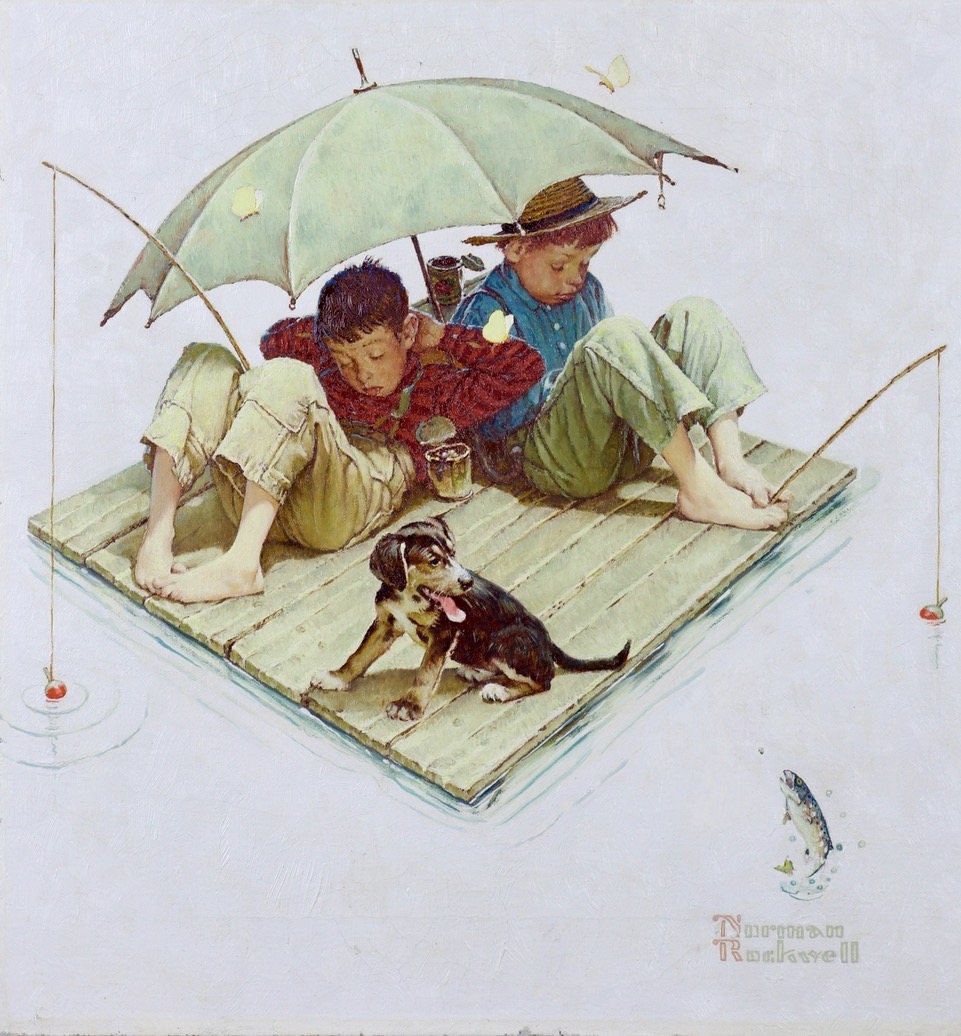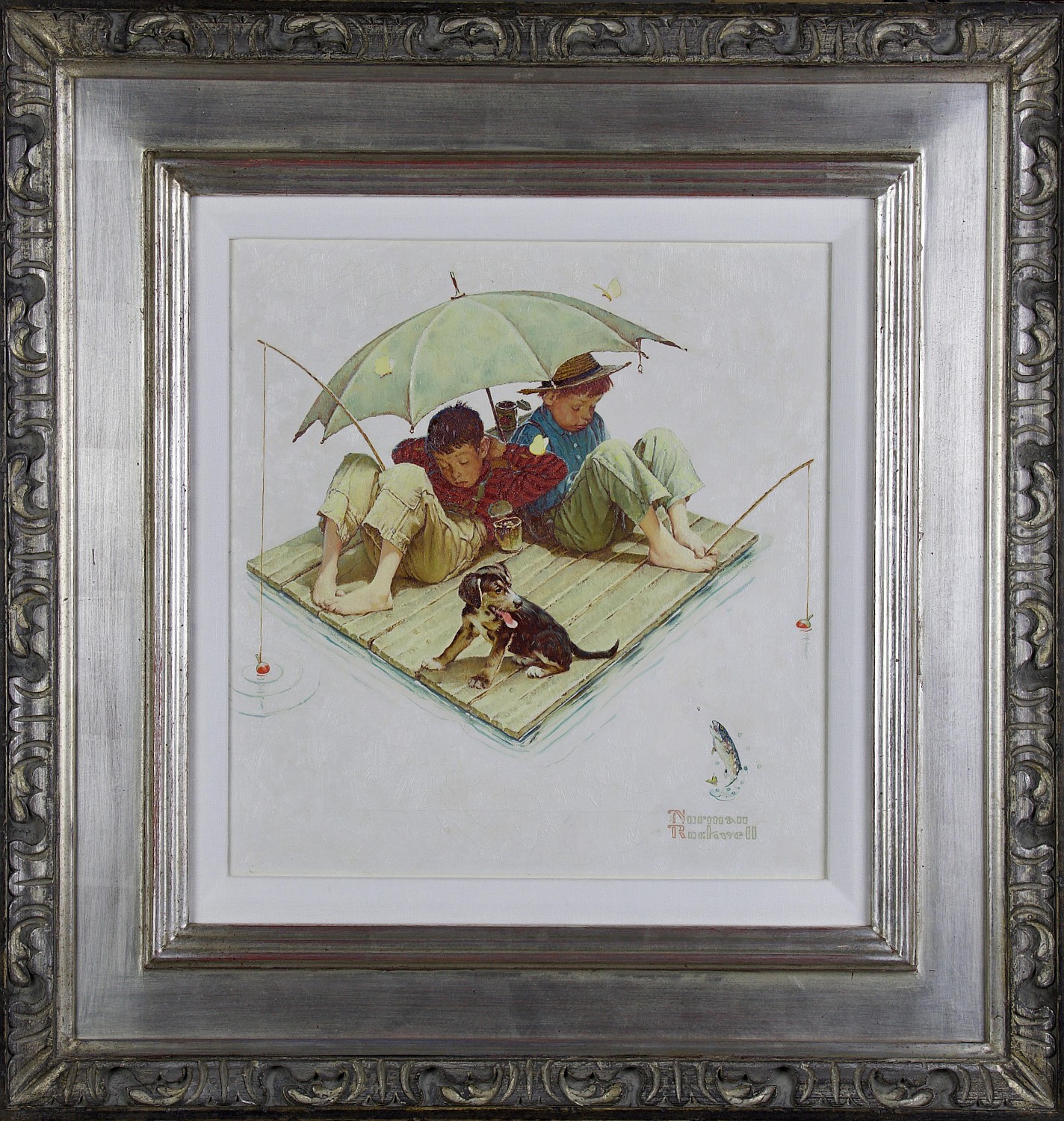"Me and my Pal: Fishing Raft" Lot no. 4719
By Norman Rockwell (1894-1978)
1954
14" x 13.25", Framed 25" x 24.25"
Oil on Canvas
Signed Lower Right
REQUEST PRICE
PURCHASE REQUEST
Brown & Bigelow Calendar Illustration
By the end of World War II, Norman Rockwell was a household name throughout the United States and considered America's most beloved illustrator. His narrative, and often comedic, illustrations were regularly featured on the cover of numerous publications, including the Saturday Evening Post, a periodical which Rockwell considered to be the "greatest show window in America for an illustrator" (L.N. Moffatt, Norman Rockwell: A Definitive Catalogue, vol. I, Stockbridge, Massachusetts, 1986, p. 72). Though his first illustration to be reproduced on the cover was in 1916, it was his works produced during the wartime years that brought him immense acclaim. In fact, the Four Freedoms series was so greatly admired, the US Treasury reprinted the images to aid with selling war bonds, ultimately raising over $130 million dollars in bonds. Rockwell's creations were greatly sought after in the post-war boom years, as his representations of Modern American life were very much in line with the patriotic and family values espoused at the time. From 1948 to 1964, Norman Rockwell was commissioned to create Brown and Bigelow's iconic Four Seasons calendar series, which would go on to reside in over 50 million households. "The series treats NR's [Norman Rockwell's] traditional subjects in a lighthearted, episodic manner. Each quarterly scene depicts a favorite or typical seasonal activity. The calendar series was NR's own creation, and not – as he comments in an interview in The American Weekly of 30 August 1954 – 'based on somebody else's high-pressured nudging.' The young and old were his preferred models, as they remained strictly themselves, neither group wanting to 'pretty up.'" (Ibid, p. 301). In the 1954 series, including the present work, Me and My Pal: Fishing Raft focused on the seasonal activities of two boys, often with tongue-in-cheek references to the young boys pushing the boundaries of polite society. The Four Seasons annual suites put a spotlight on Rockwell's unique ability to create a cohesive narrative through a small number of images, imbuing them with a nearly cinematic quality. When each of the 4 images created annually are viewed all together, they resemble a storyboard of a film. The vignettes form the primary plot points but leave it up to the viewer to create the narrative that connects them. The subtle humor which Rockwell incorporates into these images often drives the narrative quality of the works. In the present work, Me and My Pal: Fishing Raft, the irony resides in the rainbow trout jumping out of the water in the lower right while the two young anglers are taking a rest, with only the dog acting as witness to the fish's cheerful flip of the tail. Rockwell's ability to render universally beloved scenes that resonate with almost all Americans made this series amongst the most commercially successful endeavors of his career. Rockwell's dynamic storytelling abilities are impressively rendered by his naturalistic style, which is a process that he developed over the early decades of his career. Up to the 1930's, Rockwell relied on the use of live models, which were often difficult to sit for the extended sessions he needed. At the encouragement of the younger generation of illustrators, including John Falter, Rockwell began experimenting with photography in 1937 and quickly found that the medium suited his practice. Ever a stickler for attention to detail, photographs provided Rockwell with the reference material to complete his most complex and difficult compositions. Though rather than take the photographs himself, Rockwell would hire a rotation of photographers to capture the props and models, as he preferred to act as the director of the shoot, meticulously posing and adjusting the models and their accoutrements until they met his exacting standards. When considering how the use of the camera benefited his practice, Rockwell later stated, "I feel that I get a more spontaneous expression and a wider choice of expressions with the assistance of the camera and I save a lot of wear and tear on myself and the model" (Rockwell on Rockwell: How I Make a Picture, New York, 1979, p. 92). Shortly after his implementation of utilizing photography to assist his artistic practice, Rockwell and his family moved from the busy suburb of New Rochelle, New York to Arlington, Vermont. "Now my pictures grew out of the world around me," the artist described of this important change, "the everyday life of my neighbors. I don't fake it anymore" (quoted in Susan E. Meyer, Norman Rockwell's People, New York, 1981, p. 64). Rockwell found the rural pace of life here to suit his needs and found that the local neighbors, including their pets, were perfectly suited to serve as his models. "Three of his favorite children were Chucky Marsh and Pete and Mary Whalen of Arlington, Vermont. The three are featured in the 1954 series." (Moffatt, p. 301). In the present work, Rockwell has positioned the two boys, Chucky and Pete, into relaxed, semi-supine positions, with each boy resting his upper body on a wooden crate, knees bent, and toes pointing inward. Pete (on the left) has his hands resting behind his head and the fishing pole balanced between his knees, whereas Chucky, is living far more dangerously with the fishing pole clenched precariously between his toes. These small but important aspects of their body language convey to the viewer the complete relaxation the boys are feeling, which can only be achieved on a raft in the river, with a belly full of beans and not a single care in the world. The only character in the scene who appears to be aware of what is happening is the dog. Animals have long been considered extensions of the American family, particularly dogs and cats, and Rockwell regularly included them as an integral part of the narrative rather than as a prop or appeal to animal lovers. In his own words, Rockwell once reflected "It takes much kindness and patience to handle animal models, but the effort is worthwhile because they are so often important elements in story telling pictures. . . . I do not like to see an appealing animal put into a picture just to save a job. This trick does not fool anyone. I never include an animal in any picture unless it seems natural for it to be in the setting. But when you have a scene in which animals might be expected to appear, paint them well and put them in because people love to see them" (Ibid, p. 108).
Literature:
M. Moline, Norman Rockwell Encyclopedia: A Chronological Catalog of the Artist's Work (1910-1978), Indianapolis, Indiana, 1979, pp. 232-33, fig. 8-55F, illustrated. (as Brown & Bigelow, Four Seasons Postcard Calendar) L.N. Moffatt, Norman Rockwell: A Definitive Catalogue, vol. I, Stockbridge, Massachusetts, 1986, pp. 316-17, no. 138, illustrated.
Explore related art collections: Calendar Art / Children / $100,000 & Above
See all original artwork by Norman Rockwell
ABOUT THE ARTIST
The pictures of Norman Perceval Rockwell (1894-1978) were recognized and enjoyed by almost everybody in America. The cover of The Saturday Evening Post was his showcase for over forty years, giving him an audience larger than that of any other artist in history. Over the years, he depicted there a unique collection of Americana, a series of vignettes of remarkable warmth and humor. In addition, he painted a great number of pictures for story illustrations, advertising campaigns, posters, calendars and books.
As his personal contribution during World War II, Rockwell painted the famous “Four Freedoms” posters, symbolizing for millions the war aims as described by President Franklin Roosevelt. One version of his “Freedom of Speech” painting is in the collection of the Metropolitan Museum of Art.
Rockwell left high school to attend classes at the National Academy of Design, and later studied under Thomas Fogarty and George Bridgeman at the Art Students League in New York. His two greatest influences were the completely opposite titans Howard Pyle and J.C Leyendecker.
His early illustrations were done for St. Nicholas magazine and other juvenile publications. He sold his first cover painting to the Post in 1916, and ended up doing over 300 more. Presidents Eisenhower, Kennedy, and Johnson sat for him for portraits, and he painted other world figures, including Nassar of Egypt and Nehru of India.
An important museum has been established in Stockbridge, Massachusetts, where he maintained his studio. Each year, tens of thousands visit the largest collection of his original paintings extant.



